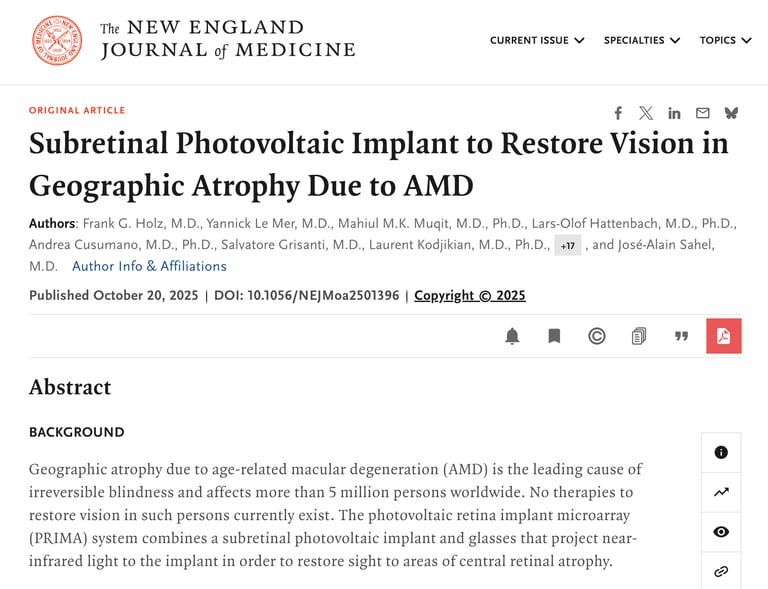Stay updated on what is trending in health. Discover tips and resources for a healthier, balanced life.
Real-Life “Bionic Eye” Brings Hope to People With Vision Loss
A groundbreaking bionic eye, the PRIMA system, restores central vision in people blinded by advanced dry AMD, offering new hope and independence.
NEWS
Dr. S. Ali
10/22/20252 min read


It sounds like something straight out of science fiction — a “bionic eye” that helps people see again. But this breakthrough is very real. In fact, it was recently reported in the New England Journal of Medicine, one of the world’s most respected medical journals.
The study focused on people who had lost vision due to geographic atrophy, an advanced form of dry age-related macular degeneration (AMD). This condition causes the light-sensing cells in the center of the retina — the macula — to gradually die off. When that happens, it creates a permanent blind spot right in the center of what you see, making tasks like reading or recognizing faces extremely difficult.
Now, a new technology called the PRIMA system is offering fresh hope — by literally reawakening sight through a form of artificial vision.
How This “Bionic Eye” Works
The science behind it is incredible — yet surprisingly elegant.
The Implant: A tiny, wireless microchip (about the size of a poppy seed and thinner than a human hair) is gently placed under the retina, right where the blind spot is.
The Glasses: The person wears a special pair of glasses with a built-in camera. This camera captures whatever’s in front of them and sends that image as invisible, near-infrared light to the implanted chip.
The New Vision: The chip transforms that light into electrical signals, stimulating the still-healthy retinal cells. These cells then send the information to the brain — essentially bypassing the damaged photoreceptors and restoring a form of artificial central vision.
It’s like reprogramming the eye to see again using its remaining healthy parts.
The Results So Far
The early results have been truly remarkable. After one year:
81% of participants showed a meaningful improvement in their vision. Some could read several lines lower on an eye chart — a huge step up from only seeing the largest letter before.
Central vision was restored. People were able to locate objects, distinguish contrasts, and even read letters and short words using their new “prosthetic” sight.
Natural side vision stayed intact. The implant only replaces the lost central vision, so participants could still use their natural peripheral vision at the same time — a best-of-both-worlds outcome.
Is It Safe?
As with any eye surgery, there were some risks — like temporary increases in eye pressure or mild retinal changes — but most were manageable and resolved with treatment. For many patients, the chance to regain some vision was well worth it.
Why This Matters
This is a major milestone in vision science. The PRIMA system represents one of the first wireless retinal implants to meaningfully restore useful vision in people who were otherwise blind from dry AMD.
It’s not perfect 20/20 vision, but it’s life-changing — allowing people to perform visual tasks again and regain a sense of independence. For those living with geographic atrophy, this isn’t just a technological success — it’s a new source of hope.
Source:
New England Journal of Medicine.
https://doi.org/10.1056/NEJMoa2501396
Pulse Your Health
Empowering you to achieve your health goals.
Contact
© 2025. All rights reserved.
Disclaimer: The content on this website is for informational purposes only and is not medical advice. Always seek the advice of your physician or other suitably qualified healthcare professional for diagnosis, treatment and your health related needs.
